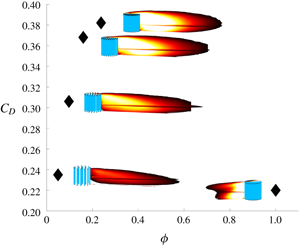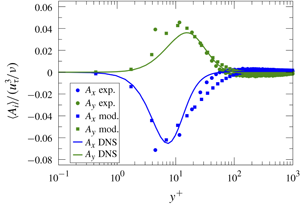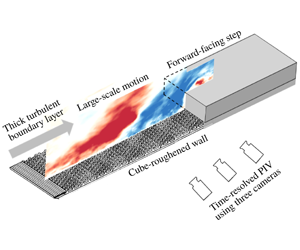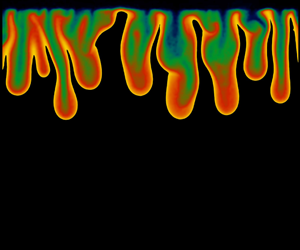The properties of the wake generated by a porous body fully immersed in a turbulent boundary layer are experimentally assessed. The body consists of an array of cylinders, with diameter  $d$, covering a circular patch of diameter
$d$, covering a circular patch of diameter  $D$. For fixed
$D$. For fixed  $d$ and
$d$ and  $D$, by increasing the number of cylinders,
$D$, by increasing the number of cylinders,  $N_{c}$, within the patch, the wake properties are systematically tested under different levels of density (
$N_{c}$, within the patch, the wake properties are systematically tested under different levels of density ( $\unicode[STIX]{x1D719}$
$\unicode[STIX]{x1D719}$  $=$ covered planar area per total surface) and compared to the flow past a solid body of equivalent diameter and height (
$=$ covered planar area per total surface) and compared to the flow past a solid body of equivalent diameter and height ( $H$). Some insights on the complex flow developing in the wake are captured:
$H$). Some insights on the complex flow developing in the wake are captured:  $\unicode[STIX]{x1D719}$ varying in the range 2 %–24 % results in the flow meandering among the cylinders and bleeding from the top, the sides and the trailing edge of the patch. The interplay between trailing edge and top bleeding prevents wake entrainment, locking the wake longitudinal extent to 5–7 patch diameters, regardless of the density level. Due to the finite body vertical extent, a third shear layer develops from the top of the patch. The interaction between the top shear layer and the lateral ones leads to a mutual alteration, namely a nonlinear growth not captured by the classical mixing layer theory. Nevertheless, on the horizontal plane at the patch mid-height, the mean flow recovers, exhibiting a self-similar decay. Surprisingly, the recovery is well described by the classical planar wake theory and the characteristic scales, namely the maximum velocity deficit and the wake half-width, evolve linearly as proposed by Wygnanski et al. (J. Fluid Mech., vol. 168, 1986, pp. 31–71).
$\unicode[STIX]{x1D719}$ varying in the range 2 %–24 % results in the flow meandering among the cylinders and bleeding from the top, the sides and the trailing edge of the patch. The interplay between trailing edge and top bleeding prevents wake entrainment, locking the wake longitudinal extent to 5–7 patch diameters, regardless of the density level. Due to the finite body vertical extent, a third shear layer develops from the top of the patch. The interaction between the top shear layer and the lateral ones leads to a mutual alteration, namely a nonlinear growth not captured by the classical mixing layer theory. Nevertheless, on the horizontal plane at the patch mid-height, the mean flow recovers, exhibiting a self-similar decay. Surprisingly, the recovery is well described by the classical planar wake theory and the characteristic scales, namely the maximum velocity deficit and the wake half-width, evolve linearly as proposed by Wygnanski et al. (J. Fluid Mech., vol. 168, 1986, pp. 31–71).




















